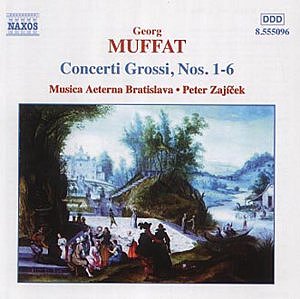 |
George MUFFAT (1653-1704) CONCERTI GROSSI Volume 1 Concertos No. 1 in D minor- Bona nova; No. 2 in A major - Cor vigilans; No. 3 in B major - Convalescentia; No. 4 in G minor- Dulce somnium; No. 5 in D major - Saecolum No. 6 in A minor- Quis hic? Recorded Moyzes Hall Warsaw February 1993 Crotchet AmazonUK AmazonUS Amazon recommendations |
The first thing to say is that this is a new release, despite the fact that it was recorded over 8 years ago. Why it has been sitting in the Naxos vaults I cannot tell. Actually I feel sorry for the performers, who must have wondered all this time what they had done wrong. We all move on, personnel change, performance style and direction changes, so that after eight years when their new recording emerges the sound of an ensemble can be quite different. Especially I feel here, where the thirteen or so players each play an 18th Century instrument except for one viola of 1810. Players change their instruments, create different ways of producing the tone, they learn more about what the instrument can do. It is unfair of Naxos to do this and I hope that the ensemble in question is not too troubled by it.
After that gripe, I suppose that it is true to say that Muffat would be an early example of a perfect Europhile. Reading Keith Anderson's rather over succinct insert-notes it seems that Muffat's father was Scottish, his mother was French but he regarded himself as German. He lived for a while in the Alsace and was a pupil of Lully in Paris. He worked in Vienna and later Prague and even later Salzburg. He studied in Rome with the redoubtable Bernardo Pasquini where he was an organist, and he met, (perhaps most importantly in this context) Corelli, and heard his Concerti Grossi. He also lived in Rome for a time. O, how the world was such a small place in the late 17th Century!
Not surprisingly, Muffat attempted, in these concertos, a synthesis of French and Italian style, (although the pervasive melodic style is Germanic) as exemplified by Lully and Corelli - the two composers he seems mostly to have admired. They were published, according to the other booklet essayist Vladimir Godar, in 1701 in Passau, the town where Muffat died suddenly aged 50. Francois Couperin's similar attempts in his 'Apothéose de Lully' and 'La Parnasse ou l'Apothéose de Corelli' are slightly later works and anyway are quite separate compositions from each other. Muffat mixes the two styles in one concerto. The passage of time inevitably blurs the finer distinctions between musical styles that were originally quite dissimilar. During the late 17th and early 18th centuries, a heated partisanship existed in France between the upholders of 'douceur'; and sophisticated charm, deriving from the opera-ballets of Lully, and the admirers of the new Italian violin school of Corelli, characterised by its brilliance, singing quality and structural strength. Couperin showed an uncommon breadth of musical sympathies and so did George Muffat, in fact even more so.
Even more remarkably, for these works, Muffat's last published compositions, the composer undertook an extended revision of his earlier 'Armonica tributo' of 1682. I quote Godar "From the five sonatas he devises six concertos" (numbers 2 and 4 on this CD). This second version "involves various changes in the organisation and length of movements and the inclusion of the continuo in the concertino group". He goes on "Muffat completed the work with six compositions dating from his period in Salzburg between 1683-1689. Here he combines the French and Italian elements … which up till then had been kept distinct." All Muffat's concertos are essentially divided into two parts introduced by two movements in Italian style. The first of these is an introductory sonata with a slow sections marked Grave, proceeding to a faster tempo, and sometimes followed by the slow tempo again. These are followed by French dances i.e., Gavota, Rondeau, Giga. Borrea etc. Each concerto has therefore five tracks - the French movements always taking the last two.
The curious titles attached to these works apparently refer to the occasions of their first performance and have no bearing upon the music, although I must admit that the exciting and flashy opening Allegro to the 6th Concerto 'Quis hic? (Who is this) seems to be pointing a finger at someone.
It is interesting how this charming and tuneful music is perceived now. My wife described it as perfect dinner party music. Derisory? Well, this music might well be important in the development of late Baroque styles in Bach and Handel but its undemanding banter is a perfect foil for late evening enjoyment. And who is to say that that wasn't its original function. After all Chamber Sonatas of this period were for private consumption and the CD admits that these works were for court entertainment. It is also difficult to imagine all of the music's first hearers paying it complete attention.
The recording may be considered a little top heavy. I could not completely redeem this problem by turning down the treble on my amplifier. However, at the cost of less than an average bottle of wine to go with the party, this music can only enhance and grace your entertainment, and some of the beautiful playing, particularly in the slow movements, may, with a more enlightened guest be a talking point.
Gary Higginson
See also review by Terry Barfoot